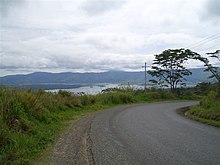Ramu
|
Ramu Otilien River ( former name ) |
||
| Data | ||
| location | Madang ( Papua New Guinea ) | |
| River system | Ramu | |
| source | in the Kraetkegebirge | |
| muzzle |
Broken Water Bay of the Bismarck Sea (Pacific Ocean) Coordinates: 4 ° 1 ′ 0 ″ S , 144 ° 39 ′ 59 ″ E 4 ° 1 ′ 0 ″ S , 144 ° 39 ′ 59 ″ E
|
|
| length | 640 km | |
| Right tributaries | Songeram | |
| Communities | Dumpu , Bunapas | |
| Navigable | at least 310 kilometers | |
| in the rainy season it joins the Sepik river system | ||
|
Aerial view of the Ramu |
||
The Ramu is a river in northern Papua New Guinea .
Location and course
Its headwaters are in the Kraetkegebirge , from where it flows about 640 kilometers through the province of Madang in a north-westerly direction.
During his way, numerous tributaries from the Bismarck Mountains as well as the Finisterre and Adelbert Mountains pour into the Ramu. The river flows into the Broken Water Bay of the Bismarcksee approx. 20 km southeast of the Sepik estuary . During the rainy season, the Ramu and the Sepik unite in the flooded plain not far from the estuary.
nature
The Ramu National Park is located in the Ramu catchment area .
history
For thousands of years, local indigenous tribes have lived in villages along the river, which is the basis for food, transport and culture.

German exploration
The area around the Ramu was part of Kaiser-Wilhelms-Land , where the German Empire founded German New Guinea in 1884 . The Germans explored their territory quickly, and so the Ramu was discovered in 1886 by Vice Admiral Georg von Schleinitz , who had actually undertaken an expedition to the Sepik and came across the estuary on his return to Finschhafen . Schleinitz named the river "Ottilienfluss" after his ship, which was called Ottilie .
The course of the Ramu was first discovered ten years later (1896) by the Kaiser Wilhelmsland expedition . Karl Lauterbach , a botanist , had led a New Guinea Company expedition to find the sources of the Markham River . After the team had crossed the Oertzenberg Mountains from the Astrolabebai south of Madang , instead of the Markham they encountered an unknown river flowing to the northwest. Lauterbach then followed the Ramu, which he had discovered with it, for a while by canoe, but when the supplies dwindled, they returned to the coast on the same route.
Another German researcher, Ernst Tappenbeck , who had previously accompanied Lauterbach, led the Second Ramu Expedition in 1898 . Tappenbeck's order was to find out by tracing the Ramu upstream whether the “Ottilien River” discovered in 1886 was identical to the Ramu found by Lauterbach. He was accompanied by former officers of the Prussian army, a company official and an Australian gold prospector named Robert Phillip . The crew traveled with the steamer Duke Johann Albrecht, who belonged to the New Guinea company.
After a few days of traveling up the Ramu, Tappenbeck left his fellow travelers in a well-equipped camp because the water level sank. He returns four and a half months later in another steamer called the Duchess Elisabeth , whereupon the expedition team was able to penetrate 310 kilometers into the Ramu. You could go even further by canoe. At the end of 1898 a station was established on the river, the Ramu and its tributaries were mapped and a large botanical collection was compiled.
The Germans carried out further expeditions to look for gold and botanical finds. In 1902, Hans August Lorenz Klink and Johannes Schlenzig founded a station that was later connected to the coast by a bridle path. In 1902 Rudolf Schlechter led a research trip to look for gutta-percha trees. In 1907, the Austrian explorer Wilhelm Dammköhler led an expedition into the Markham Valley , connecting the sources of the Markham and the Ramu for the first time.
Australian administration
After the First World War, German New Guinea came under Australian control. In 1936 the Briton Lord Moyne ventured up the Ramu on an expedition to Indonesia and New Guinea. Moyne discovered a tribe of pygmy-like people who inhabited the region of central Ramu about 270 kilometers from the mouth of the river. These people are now called Aiom and reach an average height of 1.27 m.
The "Upper Ramu Hydroelectric Project", also known as the "Yonki Dam", located 23 kilometers south of Kainantu in the Arona Valley, supplies Lae , Madang and most of the highlands with electricity.
Web links
- The Sepik – Ramu System , vims.edu (hydrography, English)
Individual evidence
- ↑ a b c d e Hans-Jürgen Ohff: Empires of enterprise: German and English commercial interests in East New Guinea 1884 to 1914. ( Memento of the original from February 19, 2014 in the Internet Archive ) Info: The archive link was inserted automatically and still Not checked. Please check the original and archive link according to the instructions and then remove this notice. (PDF; 2.02 MB) Dissertation University of Adelaide, School of History and Politics, 2008 p. 145.
- ^ Nancy Sullivan & Associates Ltd .: Middle to Lower Ramu subsistence, household and culture study second revision. ( Memento of the original from April 20, 2013 in the Internet Archive ) Info: The archive link was inserted automatically and has not yet been checked. Please check the original and archive link according to the instructions and then remove this notice. (PDF; 7.36 MB) December 2009, January 2010.


